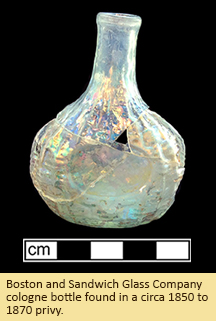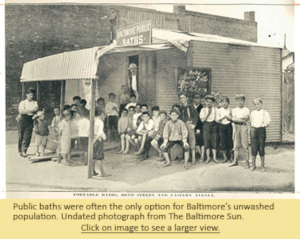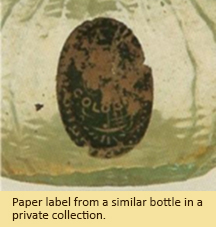Curator's Choice 2017
Smelling Sweet, Mid-19th-Century Style
August 2017
By Richie Diguiseppe and Dalton Woody,
Huntingtown High School Archaeology Club

 In the 1800s, personal hygiene methods were different than they are in the modern era. Due to the lack of running water and misconceptions about the causes of many diseases, there was often not as much emphasis on personal cleanliness as there is today. Many people used washbasins and pitchers of water to take regular sponge baths, but full immersion bathing was difficult without running heated water.
In the 1800s, personal hygiene methods were different than they are in the modern era. Due to the lack of running water and misconceptions about the causes of many diseases, there was often not as much emphasis on personal cleanliness as there is today. Many people used washbasins and pitchers of water to take regular sponge baths, but full immersion bathing was difficult without running heated water.
Public baths have been a part of urban living since at least the Roman times, but the public bath movement in North America began in the mid-19th century. Increasing immigration from Europe and crowded living situations in cities brought about the need for public bathing facilities. A number of public bath houses, administered by the city, began to appear in Baltimore at the turn of the 20th century. These baths were heavily used for decades, but the final bath closed in 1959 as part of a set of city-based austerity measures (Rasmussen 2006).
 Many people in the 19th century would be characterized today as dirty because of body odor. Yet, even then, smelling bad was still undesirable. These circumstances led to the use of perfumes and colognes, especially by the middle and upper classes who could afford these pleasant commodities.
Many people in the 19th century would be characterized today as dirty because of body odor. Yet, even then, smelling bad was still undesirable. These circumstances led to the use of perfumes and colognes, especially by the middle and upper classes who could afford these pleasant commodities.
 This perfume bottle, found in a Baltimore privy, was made by the Boston & Sandwich Glass Company of Sandwich, Massachusetts (Boston and Sandwich 2017). The company operated between the years 1826 to 1888, producing blown and pressed glass products (Barlow and Kaiser 1998). The tiny bottle, measuring only three inches tall, was made in the shape of a much larger bottle called a carboy or demijohn. These bottles, ranging in size from 5 to 16 gallons and used to transport bulk liquids like vinegar or acid, were covered in woven wicker to prevent breakage. This little cologne bottle dated between circa 1845 and 1865, a date range that fit nicely with the privy fill date of between 1850 and 1870.
This perfume bottle, found in a Baltimore privy, was made by the Boston & Sandwich Glass Company of Sandwich, Massachusetts (Boston and Sandwich 2017). The company operated between the years 1826 to 1888, producing blown and pressed glass products (Barlow and Kaiser 1998). The tiny bottle, measuring only three inches tall, was made in the shape of a much larger bottle called a carboy or demijohn. These bottles, ranging in size from 5 to 16 gallons and used to transport bulk liquids like vinegar or acid, were covered in woven wicker to prevent breakage. This little cologne bottle dated between circa 1845 and 1865, a date range that fit nicely with the privy fill date of between 1850 and 1870.